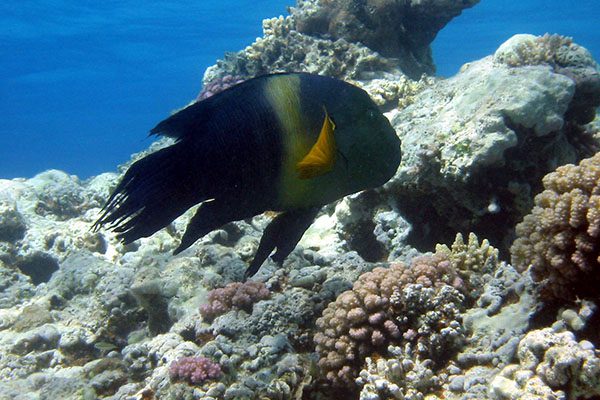The Reef’s Hard-Mouth Hunter: Ecology & Dynamics of Broomtail Wrasse (Cheilinus lunulatus) in Marsa Alam
In the intricate, living architecture of Marsa Alam’s coral reefs, every creature plays a vital role in maintaining the delicate balance of this underwater city. Among the more formidable and fascinating residents is the Broomtail Wrasse (Cheilinus lunulatus). More than just a fish of striking beauty and an iconic tail, this robust species is a highly specialized predator, whose powerful jaws and unique foraging strategies are crucial for shaping the invertebrate communities of the Red Sea. Sambo Divers Marsa Alam invites you to explore the fascinating ecology and dynamic life of this hard-mouth hunter, revealing its indispensable contribution to the reef’s health.
The Reef’s Shell Crusher: Ecology and Feeding Strategies
The Broomtail Wrasse is a formidable predator, perfectly equipped for its preferred diet:
- Specialized Molluscivore/Crustacean Feeder: Unlike many fish that target smaller, soft-bodied prey, Cheilinus lunulatus specializes in consuming hard-shelled invertebrates. Its powerful, muscular jaws and robust, conical teeth are perfectly adapted for crushing the shells of mollusks (like snails and small clams) and the exoskeletons of crustaceans (such as crabs and shrimp).
- Methodical Foraging: The Broomtail Wrasse employs a methodical foraging strategy. It can be observed slowly patrolling across coral heads, over rubble zones, and along sandy patches adjacent to the reef. It will meticulously inspect crevices, flip over small rocks or coral fragments with its mouth, and peck at the substrate to uncover hidden prey.
- Opportunistic “Following”: Sometimes, a Broomtail Wrasse might be seen following other foraging fish, particularly goatfish, which churn up the sand as they search for food. The wrasse then snatches any invertebrates that become exposed. This opportunistic behavior maximizes its feeding efficiency.
- Role in Population Control: By actively preying on various bottom-dwelling invertebrates, the Broomtail Wrasse plays a significant role in regulating their populations. This helps prevent any single invertebrate species from overpopulating and potentially impacting other reef inhabitants or the coral itself.
Life Cycle and Social Dynamics
Like many wrasses, Cheilinus lunulatus exhibits interesting social and reproductive behaviors:
- Sequential Hermaphroditism: Broomtail Wrasses are typically protogynous hermaphrodites, meaning all individuals are born female. As they mature, some females will transition into males, usually triggered by social cues such as the absence of a dominant male in a territory. This allows for flexible social structures and ensures reproductive success.
- Solitary Nature: While they are often observed as solitary individuals patrolling their territories, during breeding periods, males may temporarily interact with females within their range.
- Diurnal Activity and Nighttime Retreats: These wrasses are active during the day, engaging in their foraging activities. As night falls, they typically seek refuge within crevices in the reef structure or sometimes bury themselves in the sand to avoid nocturnal predators.
Threats and Conservation in Marsa Alam’s Reefs
While the Broomtail Wrasse is a robust species, its health is intricately tied to the vitality of the Red Sea’s coral reefs:
- Habitat Degradation: The primary threat to Cheilinus lunulatus populations is the degradation of their coral reef habitats. Coral bleaching events, physical damage from storms or human activity, and pollution can directly impact their foraging grounds and the availability of their prey.
- Overfishing (Localized): While not typically a primary commercial target on a large scale, localized overfishing for food or the aquarium trade could potentially impact their numbers, particularly larger individuals.
- General Reef Health: As an integral part of the reef’s food web, the Broomtail Wrasse is susceptible to any ecosystem-wide imbalances that affect its prey base or overall environmental quality.
Sambo Divers Marsa Alam: Ambassadors for the Reef’s Balance
The Broomtail Wrasse (Cheilinus lunulatus) in Marsa Alam is a powerful and elegant testament to the specialized roles that define a healthy coral reef. Sambo Divers Marsa Alam is dedicated to fostering a deeper understanding and appreciation for these remarkable fish:
- Responsible Observation: Our expert dive guides facilitate respectful interactions, ensuring divers observe these majestic creatures without causing stress or disturbance to their natural foraging behavior.
- Ecosystem Education: We highlight the Broomtail Wrasse’s crucial role as a predator of hard-shelled invertebrates, educating divers on how each species contributes to the reef’s delicate ecological balance.
- Advocating for Reef Preservation: By emphasizing the direct link between healthy coral reefs and thriving populations of species like the Broomtail Wrasse, Sambo Divers underscores the importance of protecting Marsa Alam’s magnificent underwater world.
To witness the purposeful sweep of the Broomtail Wrasse (Cheilinus lunulatus) in Marsa Alam is to gain a deeper insight into the intricate workings of the Red Sea’s coral ecosystems. Join Sambo Divers Marsa Alam for an enriching dive experience, where you can safely marvel at these “hard-mouth hunters” and contribute to their ongoing preservation.




0 Comment